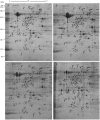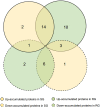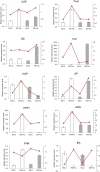Proteomic Analysis of Fusarium oxysporum-Induced Mechanism in Grafted Watermelon Seedlings
- PMID: 33747013
- PMCID: PMC7969889
- DOI: 10.3389/fpls.2021.632758
Proteomic Analysis of Fusarium oxysporum-Induced Mechanism in Grafted Watermelon Seedlings
Abstract
Grafting can improve the resistance of watermelon to soil-borne diseases. However, the molecular mechanism of defense response is not completely understood. Herein, we used a proteomic approach to investigate the molecular basis involved in grafted watermelon leaf defense against Fusarium oxysporum f.sp. niveum (FON) infection. The bottle gourd rootstock-grafted (RG) watermelon seedlings were highly resistant to FON compared with self-grafted (SG) watermelon plants, with a disease incidence of 3.4 and 89%, respectively. Meanwhile, grafting significantly induced the activity of pathogenesis-related proteases under FON challenge. Proteins extracted from leaves of RG and SG under FON inoculation were analyzed using two-dimensional gel electrophoresis. Thirty-nine differentially accumulated proteins (DAPs) were identified and classified into 10 functional groups. Accordingly, protein biosynthetic and stress- and defense-related proteins play crucial roles in the enhancement of disease resistance of RG watermelon seedlings, compared with that of SG watermelon seedlings. Proteins involved in signal transduction positively regulated the defense process. Carbohydrate and energy metabolism and photosystem contributed to energy production in RG watermelon seedlings under FON infection. The disease resistance of RG watermelon seedlings may also be related to the improved scavenging capacity of reactive oxygen species (ROS). The expression profile of 10 randomly selected proteins was measured using quantitative real-time PCR, among which, 7 was consistent with the results of the proteomic analysis. The functional implications of these proteins in regulating grafted watermelon response against F. oxysporum are discussed.
Keywords: Citrullus lanatus; Fusarium oxysporum f.sp. niveum; bottle gourd; proteomics; rootstock grafting.
Copyright © 2021 Zhang, Xu, Ren, Liu, Yao, Lou, Xu and Yang.
Conflict of interest statement
The authors declare that the research was conducted in the absence of any commercial or financial relationships that could be construed as a potential conflict of interest.
Figures






Similar articles
-
Root exudates from grafted-root watermelon showed a certain contribution in inhibiting Fusarium oxysporum f. sp. niveum.PLoS One. 2013 May 20;8(5):e63383. doi: 10.1371/journal.pone.0063383. Print 2013. PLoS One. 2013. PMID: 23700421 Free PMC article.
-
iTRAQ-based quantitative proteomics analysis of cold stress-induced mechanisms in grafted watermelon seedlings.J Proteomics. 2019 Feb 10;192:311-320. doi: 10.1016/j.jprot.2018.09.012. Epub 2018 Sep 27. J Proteomics. 2019. PMID: 30267873
-
Control of Fusarium Wilt of Watermelon by Grafting onto Bottlegourd or Interspecific Hybrid Squash Despite Colonization of Rootstocks by Fusarium.Plant Dis. 2014 Feb;98(2):255-266. doi: 10.1094/PDIS-01-13-0100-RE. Plant Dis. 2014. PMID: 30708779
-
Fusarium oxysporum f. sp. niveum Pumilio 1 Regulates Virulence on Watermelon through Interacting with the ARP2/3 Complex and Binding to an A-Rich Motif in the 3' UTR of Diverse Transcripts.mBio. 2023 Apr 25;14(2):e0015723. doi: 10.1128/mbio.00157-23. Epub 2023 Mar 1. mBio. 2023. PMID: 36856417 Free PMC article.
-
Comparative Transcriptome Analysis Reveals the Biocontrol Mechanism of Bacillus velezensis F21 Against Fusarium Wilt on Watermelon.Front Microbiol. 2019 Apr 3;10:652. doi: 10.3389/fmicb.2019.00652. eCollection 2019. Front Microbiol. 2019. PMID: 31001229 Free PMC article.
Cited by
-
Evaluation of Luffa Rootstocks to Improve Resistance in Bitter Gourd (Momordica charantia L.) Against Fusarium Wilt.Plants (Basel). 2025 Apr 9;14(8):1168. doi: 10.3390/plants14081168. Plants (Basel). 2025. PMID: 40284056 Free PMC article.
-
Histopathological and biochemical aspects of grafted and non-grafted cucumber infected with stem rot caused by Fusarium spp.Saudi J Biol Sci. 2022 Mar;29(3):1770-1780. doi: 10.1016/j.sjbs.2021.10.053. Epub 2021 Oct 25. Saudi J Biol Sci. 2022. PMID: 35280550 Free PMC article.
-
Variation of Soil Microbial Community and Sterilization to Fusarium oxysporum f. sp. niveum Play Roles in Slightly Acidic Electrolyzed Water-Alleviated Watermelon Continuous Cropping Obstacle.Front Microbiol. 2022 Apr 28;13:837121. doi: 10.3389/fmicb.2022.837121. eCollection 2022. Front Microbiol. 2022. PMID: 35572699 Free PMC article.
-
Controllable synthesis and stabilization of Tamarix aphylla-mediated copper oxide nanoparticles for the management of Fusarium wilt on musk melon.3 Biotech. 2022 Jun;12(6):128. doi: 10.1007/s13205-022-03189-0. Epub 2022 May 19. 3 Biotech. 2022. PMID: 35601642 Free PMC article.
References
-
- Beracochea V. C., Almasia N. I., Peluffo L., Nahirnak V., Hopp E. H., Paniego N., et al. (2015). Sunflower germin-like protein HaGLP1 promotes ROS accumulation and enhances protection against fungal pathogens in transgenic Arabidopsis thaliana. Plant Cell. Rep. 34 1717–1733. 10.1007/s00299-015-1819-4 - DOI - PubMed
-
- Berger S., Papadopoulos M., Schreiber U., Kaiser W., Roitsch T. (2004). Complex regulation of gene expression, photosynthesis and sugar levels by pathogen infection in tomato. Physiol. Plantarum. 122, 419–428. 10.1111/j.1399-3054.2004.00433.x - DOI
LinkOut - more resources
Full Text Sources
Other Literature Sources

